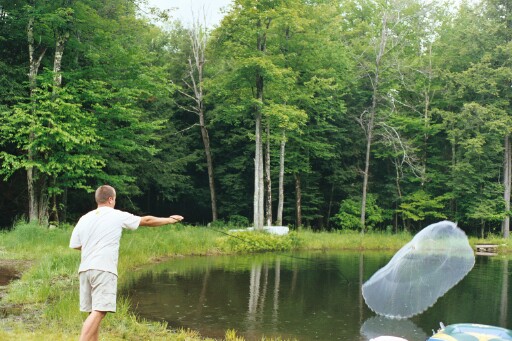
A Meshed Net is Dredging the Abyss.
A Novena by Marc Boese
June 2003

We all have our own meshed net that we may cast into the abyss. Many things pass through the net but some relevant items are caught. Even when more than one person casts his net into the same abyss, each person will dredge up different things. If several people all read the same book, see the same play or movie, or hear the same music; all will receive a different message. We gain knowledge from every circumstance, from every experience, from every acquaintance, from everything we witness. The meshed net will allow much to go through but certain objects will be seized for our individual edification. The abyss is a great big unknown world which may seem frightening, certainly there are those who prefer the safety and comfort of their known world, but it is only in casting one’s net that one might experience the wonder and awe of a newly discovered world.
THE PRELIMINARIES
Mother Earth in all Her glory with all Her gifts was the theme for this Novena. I undertook some research on past celebrations of this type as well as research on the Native Americans who lived in the Catskill Mountain region of what is now New York State. I felt it was important to find out about these nature-revering peoples and their lifestyle if I was to be true to my theme. The timing for this Novena coincides with two astronomical happenings of the year. I began on the day of the Strawberry Moon, that is the first full moon during the month of June. This year the Strawberry Moon was on June 14. The following week, June 21, was the Summer Solstice. This Novena ran June 14 through June 22. The new moon representing rebirth, new beginnings, would be an appropriate beginning, I thought .
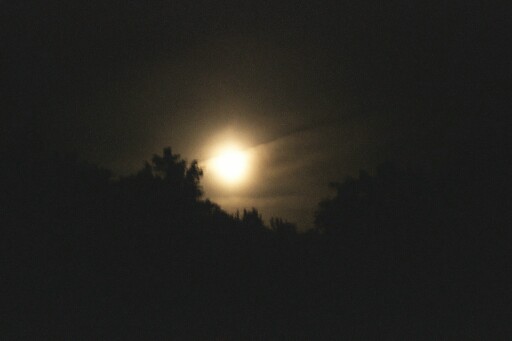
Both Eastern and Western religious traditions use novenas as nine days of prayer. In the East where odd numbers are thought to be masculine, nine represents the ultimate masculine number. Nine is the largest single digit. The Ancient Greeks had nine muses presiding over the earth. The Etruscans of northwest Italy had nine gods. The Romans thought that viable life began nine days after birth and celebrated with a ceremony on this ninth day. In the Bible (Mark 15:34.7) Christ dies at the ninth hour. It takes nine days to fully undergo a thought process change, thus a Novena.
Throughout history one can find celebrations of the Summer Solstice. The word solstice comes from the Latin sol stetit, which means, "the sun stood still". From the time the sun reaches its zenith there are about six days when the sun appears to rise and set at the exact same place (Heinberg 11). The Summer Solstice, although celebrated by numerous religions, transcends religious ideology, as it is astronomical in source. People the world over gather to celebrate and give thanks for the return of order and light (Heinberg 120). As early as the New Stone Age (8,000 years ago), stone circles, like Stonehenge, were oriented to mark the position of the rising sun at the Summer Solstice. The sun would rise over the heel stone and cast a long phallic shadow into the heart of the circle, consummating the marriage of heaven and earth. There are other circles that we know of in Imbolc, Lughnasa, Beltane, and Samhain (Franklin 4). In Chaco Canyon, New Mexico, there is a similar rock alignment upon a high butte placed by the Anassazi hundreds of years ago. In Ancient China the Summer Solstice was considered feminine and yin. Therefore, it became a summer festival of the female earth and of fertility. The Pagan Celts and the Germanic tribes celebrated with bonfires, little brothers to the sun, atop hills, as close to the sky as possible. The Islamic people of North Africa, especially Morocco and Algeria, also kindle bonfires as they dedicate the day to Fatima, daughter of Mohammed (Franklin 8-11). These are just a few of the worldwide celebrations that take place.
Deforestation, global warming, species extinction, destruction of the ozone layer, water and air pollution and our population explosion are bringing the world toward its breaking point. Our technological domination of nature and depletion of natural resources must decline, either by deliberate action or the result of famine and ecological collapse. We live in a much larger ecological and cosmic system and we must learn to live within the rules of these systems. Interfering with the natural rhythms of the world will merely frustrate ourselves; we must learn to honor the cycles of nature and the cosmos. We must realize the sacredness of nature and her gifts and treat them with reverence. This Novena was dedicated to the purpose of this realization and to give thanks for the gifts Mother Earth has given us. I attempted to get in touch with the rhythms of the earth and reaffirm my commitment to her welfare.
DAY ONE - THE GATHERING OF THE CLAN- MY FELLOW MAN
I choose the Native American term, clan, for this gathering as it best represents those who gathered. I invited my entire family to share the commencement of my Novena. Many of my brothers and sisters and their families as well as my mother traveled and visited to share in the celebration with me. Brother, Roger veered up to New York during his trek from New Mexico to the North Carolina beach with his wife and four children. He picked up my sister, Martha, and her two boys from Fort Bragg in North Carolina. Mother came up for two days from New Jersey. Brother John, his wife and three children drove over from Boston, Massachusetts. Lastly, brother, Adam and sister, Jill, came from local towns with their families. Altogether almost thirty family members shared the commencement of my Novena.
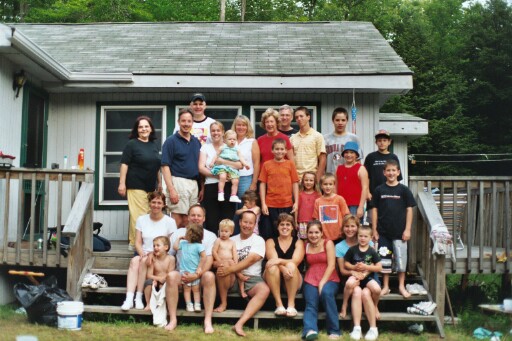
I dedicated the first day to thanking the Creator for family, friends and fellow man. There was a ritual bath in the pond scheduled to coincide with the rise of the full moon but plans were to work out otherwise. I rose early and went outside before the masses awoke to pray and meditate for a short while. My prayer, which is below, also asks for permission to use this place for the purpose of my Novena.
As each person came to breakfast or arrived, I gave them their assignment for the day. Each person was to choose a bird which they felt was representative of themselves and then create a mask or head covering of that bird. I had gotten several books from the library, both children's and adult's as reference material. I had also purchased construction paper, feathers, paints, face paints, scissors and other craft supplies for the project. Throughout the day different groups descended on the supplies or books and went to work. I have included each person's reply as to the bird they chose as well as some pictures. I chose the owl as my bird. I, like the owl, am a nocturnal person. I can be a fierce fighter when needed; the owl is a fierce predator. My wife has always said I remind her of an owl because I like to think of myself as the wise old teacher bestowing words of wisdom to my students.
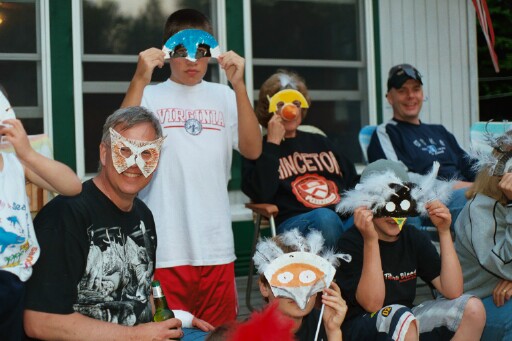
Just after lunch as I was helping one of my nephews with a fishing knife I slipped while resheathing it and punctured the web of my hand. I hit the digital artery and proceeded to spurt blood across the dock we were standing on. The "clan" ideal became very apparent over the next two hours. My brother Roger got the keys to my mother's car, which was parked at the end of the line, and drove me posthaste to the hospital. Once there, because as the nurse exclaimed, "we've got a pumper", I was seen immediately. Unbeknownst to me and furthest from my mind was the action taking place "back at the ranch". Everyone pitched in, cleaned up, finished preparing the turkey dinner and supervised the completion of all the masks. The "Chief" was taken out ill and the rest of the clan compensated and got all the jobs done effectively in his absence. It was a wonderful feeling.
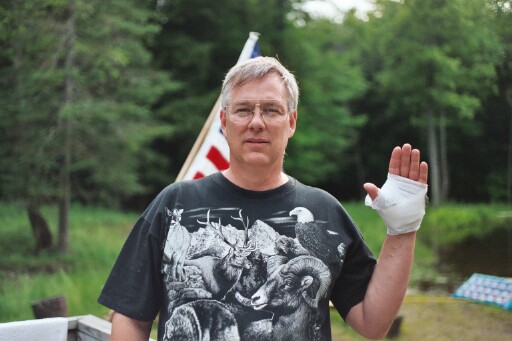
Dinner was chosen very carefully. I wanted to create a dinner using natural, local foods and preferably foods that the Native Americans would have eaten. Friday evening, my wife, Karen and I visited the local Farmer's Market to get fresh produce. We bought lettuce and tomatoes, berries, beets and beans. Turkeys are very abundant in this area and although we could only find a frozen one, it was local so we got it earlier in the week. My mother brought cornbread as she said it was the one food she always thought of as Indian food. Jill, my sister, and Cathy, a sister-in-law, brought fruit pies. We feasted for awhile then everyone shared their bird choice and showed their mask. Afterwards, we took the pictures shown here. Two of the families had busy Sundays planned so they headed out.
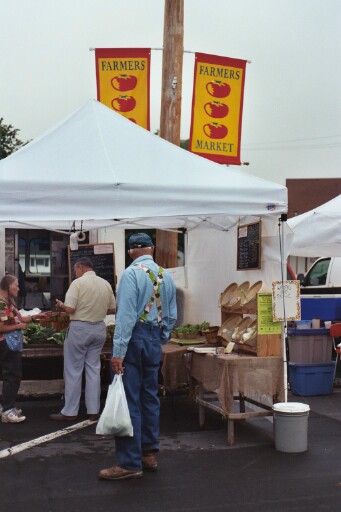
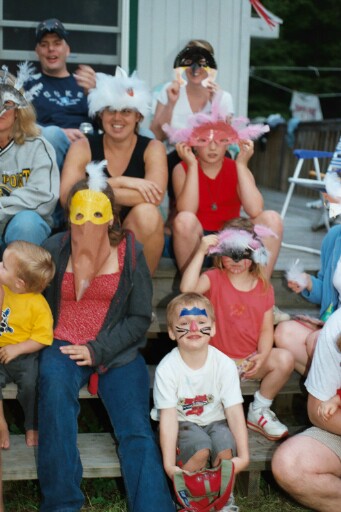
As I stated earlier, I had a ritual bathing in the water of the pond planned but now that I could not get my hand wet, plans changed. I had a mixing of my blood with the earth, how much more symbolic could I be? I did a sprinkling of the waters instead. We then had a bonfire with the ritual roasting of the marshmallows while waiting for the full moon to rise over the trees. The pictures of the full moon were taken that night.
Day One Prayer
O Great Creator, on this the day of the Strawberry Moon, I give you thanks for all your gifts to mankind.
I ask your permission to use this specific place, Willowemoc, to hold a Novena.
I thank-you today, particularly, for my fellow man: my family, my friends and my neighbors.
I pray that we learn to live together harmoniously and in accord with the rules of nature.
Let us not battle with each other but instead join in battle against the common enemies of famine, pollution, disease, and abuse of all sorts.
Let us respect the sacredness of nature.
Let me be ever mindful of your gifts and give thanks for those I use today.
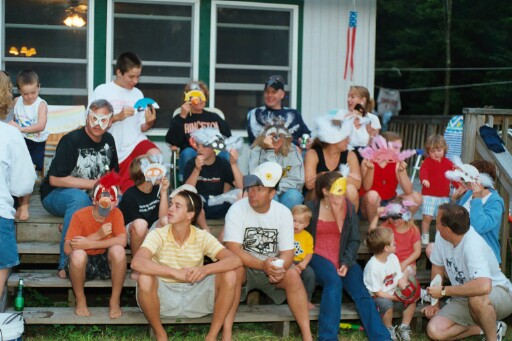
Birds Chosen
I have included everyone’s written explanation verbatim along with the ages of the non-adults.
John – Seagull – Like seagulls, I thrive at the ocean. The cries of seagulls are as much as part of the sounds of the life of the sea as the crash of the waves. The sea, like me, is in constant motion.
Matt (13) – Ostrich – They are weird, stupid birds who hide their heads in the sand.
Ben (14) – Roadrunner – I am a roadrunner because I am fast and run distances. Roadrunners are like me because I can go on forever.
Adam Jr. (12) – Toucan – I chose a toucan because they resemble me in that they are bright, wild, and don’t do much. They just sit back and relax.
Rebecca (6) – Flamingo – Flamingos remind me of ballerinas.
Roger – Osprey – The fish hunter. I also hunt the fish.
Peggy – Heron – I have long admired the heron for its dignified shyness, standing at the far edge of a pond in contemplation.
Trent – Crow – I chose the crow because I think it is an under-appreciated bird. It is big and strong and powerful and apparently does a nice job helping farmers with pesky bugs. No one likes the crow because they find it ugly or loud. Perception becomes reality – and no one loves the crow, but no one has a good reason. I love the crow.
Jill – Penguin – The penguins at the aquarium always make me laugh. They are a funny, happy bird that seem to enjoy life. They’re also loyal parents and mates.
Paul (7) – Flamingo – I picked a flamingo because they are cool and I am having a flamingo birthday party.
Karen – American Goldfinch – The American Goldfinch is the state bird of New Jersey. It is attracted to wildflowers, particularly milk thistle for food and nesting materials. I chose the goldfinch since I was born in New Jersey and I love picking bouquets of wildflowers.
Hope (1) – Duck – I am a duck because I quack a lot (one of the few words I know).
Jack (11) – Cardinal – I like red and I like cardinals.
Holly (15) – Pelican – Because they eat fish and I eat fish too.
Gina – Swan – I am always drawn to the swan because they are so calm and graceful. They represent peacefulness. They are also fiercely protective of their young, as am I.
Katherine (10) – Flamingo – I am a flamingo because they have long legs like dancers.
Adam – Eagle – I am an eagle because they can see from very far away and they soar very high.
Sam (5) – Robin – I like robins because they have blue eggs.
Michael (14) – Iberian Blue-headed Wagtail – I have always liked Spain and the Mediterranean climate.
Cathy – Eagle – I chose an eagle because they lead solitary lives which sounds very appealing at this point in my life.
Martha – Mockingbird – A mockingbird sings outside my bedroom window every morning as I wake up. I am amazed by the number of birds it can imitate – maybe 30 – plus other sounds. Apparently the mockingbird sings because he loves to sing, the song serving no otherwise practical purpose. I admire his talent.
DAY TWO- PAYING HOMAGE TO MY ANCESTORS
The second day of the Novena coincided with Father’s day. My own father died in 1989 but my father-in-law is still alive (84 years old) and lives just two hours away. My wife and I visited and took her parents to dinner. My father-in-law and I have always had a close relationship. After his retirement he came to work with me part-time at my construction company which I had at that time. My wife, Karen, was very surprised to learn that her father was just one of the guys, he cussed when he hit his thumb with a hammer and drank beer with his co-workers for afternoon break. He has taught me much about life in recent years through his acceptance of life and its uncertainties. If I didn’t know better I would have expected him to be a Taoist in philosophy. After dinner out we returned to his house and he and I walked down to the local newsstand to get his daily lottery tickets. Along the way we discussed his concerns about his wife’s deteriorating mental faculties. I think he enjoys our mano-a-mano conversations.
Later that evening after returning to our own house my mother and I honored our past relatives. We lit floating candles in their memory and set them adrift in the pond. (See pictures of this.) I felt very connected with my father sitting under the stars and watching the candles float around the pond. My father would have loved this weekend; he was a real family oriented person, who would have loved the way the family all came together for this celebration. The candles burned for over two hours as they floated around. One of the thoughts I had was that I could somehow relate to the Vikings with their burning of a great warrior in his sailing vessel set out to sea and the Indians floating their dead down the Ganges on burning pyres. The juxtaposition of fire and water is an interesting contrast that will, hereafter, always remind me of my ancestors.
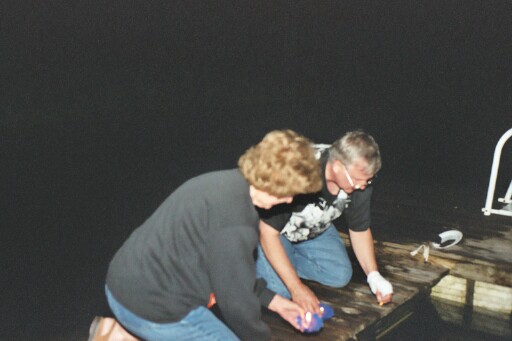

Day Two Prayer
O Great Creator, on this the second day of my Novena, I give you thanks for all your gifts to mankind.
I thank-you today, particularly, for my ancestors: my family members that have gone this way in times prior. I pray also for my living elders who still have much to offer.
I pray that I might learn from the wisdom of my elders and that I might pass some of this wisdom on to future generations.
I pray that we never forget our heritage, as it defines who we are today.
Let me be ever mindful of your gifts and give thanks for those I use today.
DAY THREE- THE NIGHT AND THE MOON AND STARS
Although the full moon was two days ago, I felt that it would be appropriate to dedicate Monday to the night as Monday was named after the moon. I rose late as I had watched the floating candles til way past midnight the night before. We spent the afternoon grocery shopping and going to the laundromat; all that weekend company depleted our stock of clean towels as well as food. After dinner, I sat by the pond and closed my eyes and just listened. There are many less frogs this year than in past summers. I guess I can blame the owl and the gray heron that keep stopping by for the depletion. I heard seven different birdcalls as well as fish jumping up to catch low flying insects. As the sun retreated over the western trees an occasional bat flew overhead in search of its dinner. Sitting there I realized how fragile this ecosystem really is. If we took the insects out, after all they are just pests, right? If we took them out of the balance the frogs and bats would starve, which in turn would starve the owl and heron, and so on. Its amazing that Mother Earth has balanced all the species so well. I know that as a species man has done more to upset the balance than any other animal. Up in the mountains, here in Willowemoc, there is NO interference of streetlights or any other lights. The stars begin to become clear as soon as the sun disappears. We can see the Milky Way clearly here.
The moon came up almost full, still, and, combined with the sky full of stars, gave an eerily abundance of light. I can see why the full moon has been associated with madness. In fact the origin of the word lunatic becomes quite apparent. The night is light enough to see, yet it is a surreal lighting, which in turn creates a whole set of incongruous colors. The whole world becomes sort of Fellini-esque in appearance.
Historically, the new moon has also had great significance, as a time of rebirth, to celebrate new life and new beginnings. Certain religions only did baptisms during the new moon or celebrated Eucharist at this time (Parrish-Harra,5).
The moon is thought to be a feminine influence, it controls the tides, bodily fluids and emotions. Studies have shown that emotionalism peaks at the full moon. Police departments, mental health counselors, and schools have done studies All attest to the peculiar and powerful emotionalism which coincides with each full moon (Parrish-Harra,11).
I don’t feel overly emotional or weird, just intense. I feel like I have been shown a great insight but I don’t quite understand it at this time. I walk around the pond scaring the remaining frogs into the water. I sit on a fallen log and just stare into the sky. It is so vast, so big. It really makes me feel insignificant in the grand scheme of things. I’ll risk sounding like a politico and say that I would like to be like a star, lighting up my small corner of this great big world. It gets chilly and I retreat to my nice warm bed.
Day Three Prayer
O Great Creator, on this Monday, Day of the Moon, I give you thanks for all your gifts to mankind.
I thank-you today for the nighttime, the darkness that promotes rest.
I thank you for the stars which offer light and direction
I thank you for the moon, which reflects the light of the sun and gives us light in the darkness.
I pray that I may better understand the vastness of the heavens
Let me not forget my place in this great cosmos
Let me be ever mindful of your gifts and give thanks for those I use today.
DAY FOUR-THE WATERS AND THE RAINS
It began raining during the night, one of those loud thunderstorms, which wake you up. It then continued to rain all day. This past winter was harsh with total snowfall measured in feet (somewhere around 4-5 feet). Then as the snows were still melting the rains began. New York State has had a drought for the past ten years. No more! The reservoirs are all at 100% capacity. Farmers are complaining for the first time I can ever remember that there is too much rain. Their crops are flooding. Watching the rain I remember a grade school science class when we drew the water cycle; the rain, the water table, the rivers and lakes, evaporation, clouds and then more rain. Later, I go for a walk in the rain. I am all alone. I get soaking wet. I stomp in puddles splashing the water every which way. Something about this reckless abandon makes me feel giddy. After drenching myself to the bone I go in and take a warm shower. Halfway through I realize the absurdity of this .
The waters of the earth bring nourishment to all living things. Whether through the streams and rivers, the ponds and lakes, the seas or just through the rain, water carries the vital nourishment.
The waters also serve as the great cleanser. I realized this as I was reading a book about the area rivers including the Willowemoc, from whence came the hamlet’s name. In Land of Little Rivers, Austin McK. Francis tells us that the original name of the river was Whelenaughwemack. This word is the Lenni Lenape Indian’s term for "the kettle that washes itself clean". Whelenaughwemack describes the annual scourings of the river’s bed and banks by the spring floods (63). Springtime flooding must scrub most riverbeds in the northern part of the country. Flash floods scrub out the riverbeds of the southwest.
The oceans with their vastness have become a favorite dumping grounds of all sorts of waste products. So far the seas have been able to handle it but soon we will be testing the ocean’s limits if we continue to be as wasteful as we are today. Look at the environmental damage caused by oil spills in recent years We cannot continue to exploit our Mother, she has her limits.
Locally, the streams have been in danger twice in the past as a result of man’s exploitation. In the mid-1800’s tanneries were the big businesses in this area. Millions of hemlock trees were cut down and stripped for the bark. The first damage was done by stripping the land of its forestation, almost totally exhausting hemlocks in the area. Secondly, this bark was made into tannic acid creating a terrible smell, air pollution. Lastly, the used product was dumped into local streams creating pollution in these waterways and killing off many of the natural fish species (Powell, 85). About sixty years later, after the streams had cleansed and revived themselves, World War One broke out. In the name of the war effort an acid factory opened on the Willowemoc River. Hardwoods were harvested and processed to make charcoal for gas masks. Wood alcohol and acetate of lime used in explosives were also processed from the cut wood. Again all the poisonous residues and acids were dumped into the river. Again wildlife was virtually wiped out for several years during and after production (Powell, 88).
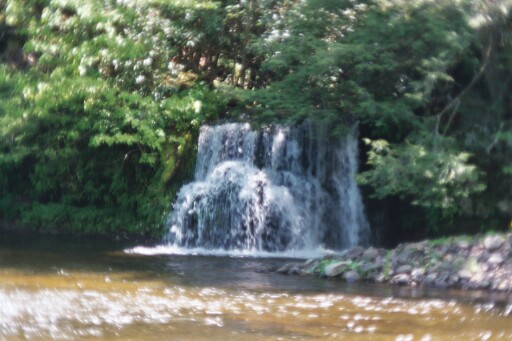
Day Four Prayer
O Great Creator, on this the fourth day of my Novena, I give you thanks for all your gifts to mankind.
I thank-you today, particularly for the waters of the earth, which bring nourishment to all living things.
I thank you for the rains that you wash down upon us from the heavens.
I pray that these waters will continue to cleanse the world for many years.
I pray that mankind might learn from the wisdom of our elders and that we might honor the waters and stop our incessant dumping in them.
Let me be ever mindful of your gifts and give thanks for those I use today.
DAY FIVE-THE EARTH, THE SOIL, ROCKS, MOUNTAINS
The midpoint of the Novena, I dedicate the day to the rocks and soil that make up the ground on which we live. The soil is the basis for most plant life that in turn sustains us. The soil also yields many of the ores for the metals we use daily. I decide to take a ride today, up over the nearest mountain in search of a trail which I will be hiking for the next couple of days. The ride extends because as I got to the top of one mountain I was overwhelmed at the sight and decided to go to the top of the next mountain. Most of these roads were little more than jeep trails and dirt roads (see pictures). I am amazed at the amount of undeveloped land. Here I am just a hundred miles from New York City, one of the biggest, most densely populated areas in the world, and I ride for hours on back roads encountering no one. This great earth is certainly not being used to her capabilities. When one considers how much land on the earth is unusable, deserts, polar ice caps, swamps and marshes it is astonishing at how well the earth does at providing for us. There are still large tracts of the earth that are not exploited. This ride today reinforces that for me. There are still millions of miles of pristine earth unadulterated by mankind’s often unkind hand.
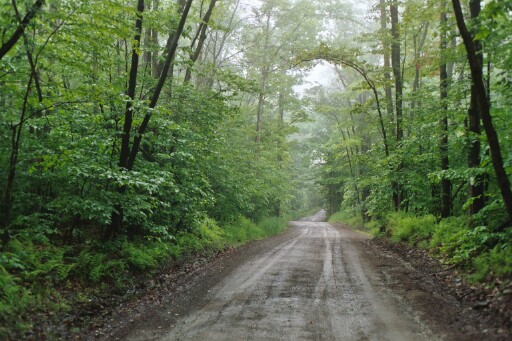
From the top of the next mountain I can see for miles and miles, probably fifty or more. This Willowemoc area is part of the Catskill Forest Preserve, established in 1885, and consisting of 273,000 acres. This acreage is one-third state owned land and two-thirds privately held. The Catskill Forest Preserve falls within the larger Catskill Park, which was created in 1904 and includes over 705,000 acres (Powell, 9). The Catskills got their name from the explorer Henry Hudson who originally called these mountains, which arose alongside the river that bears his name the Kaatskills, a name shrouded in mystery (Foster,1). The Catskills are the highest and easternmost part of the Allegheny Plateau province. The High Peaks of the Catskills rise sharply above the Hudson Valley and gradually decrease to the west. The bedrock is composed of sedimentary rock, primarily shale, sandstone and conglomerate. This explains the gentle slopes and lower elevations of the western slopes as this composition is easily eroded (Dowhan, 2). I can imagine the Lenni Lenape Indians standing here at this high tor looking out, in awe, at the surrounding mountains. The earth looks like endless rolling hills as far as one can see.
I find the trail I have looked for and head for home, the long way, around the Ashokan reservoir and up through Big Indian Valley. I prefer long slow scenic drives to rushed highway miles whenever I have the time. The ride does not disappoint me. The day after a major rainfall most of the smaller brooks and headwaters I encounter are rushing torrents. The wildlife is abundantly evident, as if relieved that the rains have ended. I decide to do some work with Mother Earth’s rocks and work for a while on a stone walkway that I am laying around the pond. I tire easily and opt for a nap in the hammock after a short time.
Day Five Prayer
O Great Creator, on this the fifth day of my Novena, I give you thanks for all your gifts to mankind.
I thank-you today, particularly for the earth, the rocks, the soils, the deserts and the mountains.
I thank you for the minerals and ores.
I revel in the beauty of your vistas, and your landscapes,
I pray that these lands will continue to sustain my fellow man and myself for many years.
I pray that mankind might honor the earth and her resources and stop our incessant abuse and depletion of these natural gifts.
Let me be ever mindful of your gifts and give thanks for those I use today.
DAY SIX- THE PLANTS
I wake early and Karen drives me eastward to Grahamsville where I will pick up the Sun Trail and hike back to the house. I have decided to dedicate this day to the flora of the earth. It is a cool morning, perfect for hiking and meditating as I walk. Because of a very late spring many of the late spring flowers, like the lilacs, are in bloom now. Along with the plentiful daisies and black-eyed-susans, these lilacs are all along my walk today. I can sometimes smell their fragrance before I can see them. Then it becomes a search mission to find them.
There are three major forest types in the eastern Catskills, from the highest elevations with its spruce-fir forest, to the middle elevations’ northern hardwoods forest, and the lower tier oak-hickory forest. The dominant forest type in these moist, well drained, acidic soils is the northern hardwood forest (Dowhan, 3). As I hike today I find myself in a forest dominated by hardwoods but with eastern hemlock co-dominating. I hike past several swampy areas, created by beavers damming up small streams and flooding out many acres of forest. I hike over several significant mountains, most notably Slawson Mountain, one of the higher peaks in the area, before getting home tired but rejuvenated spiritually, in the late afternoon.
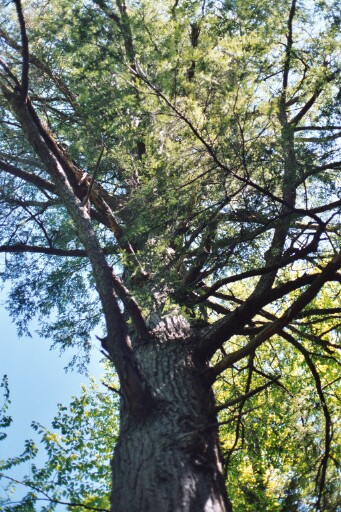
I have chosen my trail carefully. While researching the local history, I discovered that the Native Americans of the area had a trail established through the area long before the White man ever stepped foot on the American shores. In reading the History of Sullivan County by James Eldridge Quinlan and written in 1873, I got an extremely Eurocentric view of the Native Americans of this area. Quinlan tells readers that the local tribe of the Lenni Lenape Indians was the Wolf Clan, the Munsi. A few families lived along the Willowemoc River and were known as the Willowemoc Clan, a part of the Munsi (66). Quinlan calls the Indians "aboriginal" and definitely considers them a lesser species that his own, quite consistent with an 19th century Eurocentric society. More research turns up the fact that the Munsis were a mountain tribe that lived throughout the area. They were primarily hunters and fishermen but they did do some farming in the summers. A large group lived in the Warwarsing area lving in permanent long-houses. They traveled each summer to the Beaverkill area living in wigwams, temporary shelters while there. They made clay pots from local clay, cooked cornbread made with corn they had grown, and harvested and refined syrup from the maple trees. In addition to corn, in the lower valleys they grew squash, beans, sunflowers, pumpkins and gourds. In their travels they walked over the Sun Trail. The trail ran east and west from Warwarsing to Beaverkill and it was said that a brave leaving one end at sunrise could traverse the trail to the other end before sunset (Powell, 15). I had a hard time trying to find information about the Sun Trail. I found a map, undated, in a commemorative book published by the Livingston Manor Board of Education that is perhaps the best map available showing the route of the Sun Trail. The original map is apparently archived at the State Board of Education in Albany (Willis, 33). In 1812, local property owner John Hunter hired Abel Sprague to cut a road from Halls Mills to Shin Creek in Beaverkill. Sprague was instructed to follow the Sun Trail. This road became known as Hunter road and much of it remains today (Powell, 23). Using the old school system map, a county street map and two USGS topographic maps plotted out where the Sun Trail lay. There were a few areas where I could find no roads or trails to connect portions of the trail and here I followed contours around major obstructions, as it was evident from other areas that that had been the policy. The portion of the trail which I hiked today was along the modern day Hunter Road, a paved rural road wending its way along through the woods and across the Willowemoc River about a half mile from my cabin. Tomorrow it will be westward ho!
When I get back to the cabin in early afternoon, Karen and I went to a local nursery. I wanted to plant an indigenous tree alongside the pond and the ground was very wet. The nursery owner who assured me that willow trees were not only indigenous but they loved lots of water confirming my studies of local trees. I settled on a weeping willow and took it home to plant. I was warned that while the tree was young, bucks would try to use it as a rubbing post for their antlers. A stop at the hardware store fixed me up with a short piece of fencing and some metal stakes. After dinner, I planted the willow and installed the fence around it (see pictures).
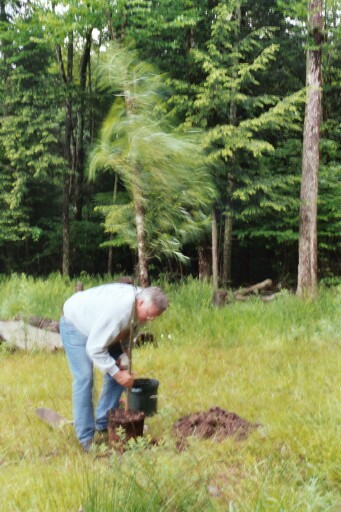
Day Six Prayer
O Great Creator, on this the sixth day of my Novena, I give you thanks for all your gifts to mankind.
I thank-you today, particularly, for the plantlife you have given us.
I thank you for those plants that offer man food and nutrition, those which offer beauty and sweet aromas, and for those which bring food to all your other creatures.
I thank you for the trees that offer shade and lumber for building.
I pray that I never take these gifts for granted.
I pray that mankind uses these and other resources prudently without depletion.
Let me be ever mindful of your gifts and give thanks for those I use today
DAY SEVEN- THE ANIMALS
Today I hike westward from the house, first along a paved road, then off onto a jeep trail then at two points off into the woods for half-mile uncharted jaunts to connect up with another section of the trail. Again, I start off early in the day, Karen will pick me up this afternoon at Shin Creek about nine miles away. I carry very little, a sandwich, fruit and a canteen with water. As I did yesterday, I am counting on refilling my canteen at mountain streams along the way. Today the hiking is a little more difficult especially the two sections through the woods. The contour maps showed me that there were hills in both cases to be traversed but it didn’t show the berry brambles or marshy ground I encountered. Both of these exacerbated by the very wet weeks prior. Berry bushes like the water and grew hardy and large. The rains also kept the ground quite wet and when I hit a low area it turned marshy. These made for a long rerouting around the bushes and some very slow going through the marshy area. Also, today there seemed to be an abundance of bothersome black flies. I did come across a field of six deer from downwind, including two fawns still with their spots. I surprised them and they didn't know what to make of me. We stood just staring at each other for several minutes before they bounded off. I also ran into an old gray porcupine ambling across my path. He stopped and we did the staredown, as well, before he slowly ambled away. Porcupines look funny when they walk, kind of shifting their butt back and forth as they go. I was hoping to see my totem, the owl, but he did not grace me today. As I ate lunch near an open field I did see a bald eagle high in the sky riding the thermals. His white head and tips of his wings made him quite distinguished. These eagles use the reservoirs and lakes to nest and live year-round. They are part of a reintroduction effort that has released about 200 eagles since 1976. Pairs have successfully nested and fledged young in the past few years. The Catskill area now hosts the largest concentrations of bald eagles in the state and one of the largest in the northeastern United States (Dowhan, 7). The Catskills support over 120 species of birds, a large number of reptile and amphibian species many of which are regionally rare, the legendary fish especially trout, and numerous mammals including several large species. There are about 300 black bears, some bobcats and now, thanks to a reintroduction program, fishers are common again (Dowhan, 8).
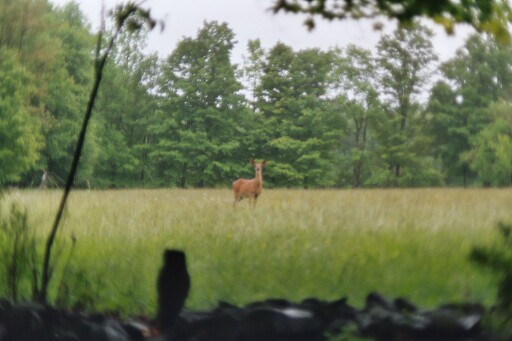
Conservationists feel that there is a threat from mankind in several areas. Continued construction activities including roadwork and run-off from agriculture are the two biggest concerns. Irresponsible logging strips the land of its cover and makes it vulnerable to erosion as well as depleting natural habitat. Lastly, the legendary natural brook trout are being threatened by habitat alterations as well as competition from introduced species (Dowhan, 8).
Hiking through the woods I see no evidence of any of these threats but I know they are there. I resolve to do what I can to educate people about the problems and work toward a resolution in harmony with nature.
I am late for my afternoon rendezvous and ride home. As I come down the hill into the community of Shin Creek I spot Karen reading a book, in a lawn chair alongside the creek under a large maple tree. How idyllic the scene looks. I am hot, tired, and bug bitten but very much at peace with the world. I feel quite connected to Mother Earth today.
Day Seven Prayer
O Great Creator, on this the seventh day of my Novena, I give you thanks for all your gifts to mankind.
I thank-you today, particularly for the animals of the earth.
I thank you for the birds that fly overhead, the small creatures that crawl, slither, swim, fly, and run around this beautiful earth and the large creatures that share this world of yours.
I pray that mankind might learn to live harmoniously with all the other creatures we have been asked to share this world with.
I pray that mankind might stop decimating and depleting the habitat of any and all fellow creatures.
Let me be ever mindful of your gifts and give thanks for those I use today.
DAY EIGHT- THE SOURCE OF LIGHT, THE SUN
Today is the Summer Solstice. If we think of the sun as the source of light, power and life, then today could be considered as our Max-out day. Today will be dedicated to the sun, that glorious ball of fire around which our whole world revolves. This source of all life is a fitting reminder to renew our bonds with nature and our connection to the earth. The Summer Solstice is the turning point in our year, the first half is a time for rebirth and renewal, after the solstice daylight begins to wane. It is a good time to reflect and consider the delicate balance of our relationship with the sun, any less and we might freeze in another ice age, any more and we might broil ourselves to death.
Heinberg, in his book, Celebrate the Solstice, states that the solstice is a turning point from the female energy, the yin, to the male energy, the yang. The Solstice itself has the divine feminine energies at their peak (114).
Since early man the solstice has been a time for celebration. Light has always been an artistic inspiration and on this day of maximum light it is only natural that we celebrate through artistic expression. I chose to weave a wreath from birch sticks. A I began by tying several ends together and weaving others in, I left the thin ends sticking out planning to weave them in later. It struck me that this open wreath with sticks emanating from the circle was representative of my life. I stopped working and labeled the wreath completed. There are pictures of my wreath. If viewed one way the emanations show all the people and circumstances that have come into my life influencing it as I went along. Viewed in reverse the emanations represent my reaching out to "touch" others. As a teacher, I hope to reach out to many children and have a positive impact on them. Life is a constant circle of give and take, being influenced and influencing, of yin and yang. The circle of life goes on. I hung the wreath on the side of the house where see it every day. Over the next winter it will probably fall apart or maybe blow away in a windstorm t, to decay and provide food for the next generation of tree. Life, the big cycle. The wreath will remain with me forever as a representation of my own finite life.
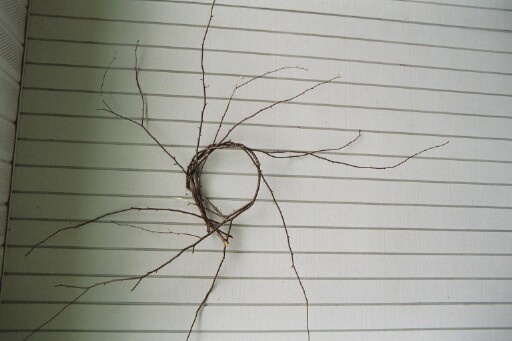
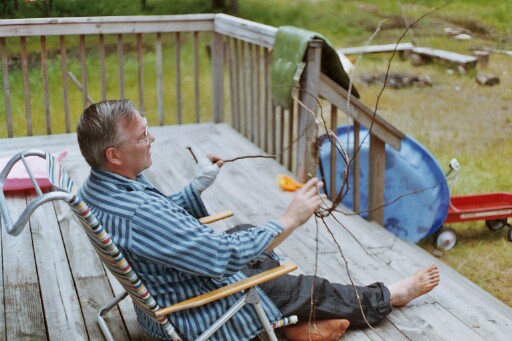

I asked my classmates and some other friends to join me in a cross-country observance of the solstice today. We had about a dozen people coast-to-coast join in an energy fast, only using what was necessary, some hanging out, some hiking, and all joining around three o’clock (actual time of the solstice) to pray together. Our prayer follows.
Day Eight Prayer
Summer Solstice Prayer
O Great Creator, on this the longest day of the year, we give you thanks for the sun, the source of light, warmth, and life itself. The sun brings forth life each spring and continues to nourish all living things throughout the year.
On this the turning point of the year, when solar energies are at a peak, let us learn to live in harmony with the rhythms of the earth and renew our bonds with nature. Let us live within the rules of our larger ecological and cosmic universe instead of frustrating ourselves trying to adapt them to our desires.
Let us strive to be mindful of all your gifts and treat them with reverence and respect. Let us not be wasteful or indulgent taking only that which we need.
Creator, thanks for all your gifts of which we partake daily. Amen
DAY NINE- REFLECTION
Reflection has actually been an ongoing process but I wanted a day to just lay back and meditate about the Novena in total. I resolve to never take this earth for granted again. I resolve to do my part to conserve our resources and to help educate others to do the same. I felt a real connection to my ancestors throughout the Novena. I kept imagining myself a member of the Willowemoc clan as I hiked their Sun Trail. I will take more time to breathe deep and absorb the energies of the earth. There were some projects I did not get to that I had planned, a circle of rocks garden with divisions in the four directions, a drum made from a log, a drumming ceremony, and carving a totem pole. These projects will not be forgotten, they will come to fruition. I am very thankful for the opportunity to be able to set aside the time for this spiritual renewal. I will do it again.
Day Nine Prayer
O Great Creator, on this the last day of my Novena, I give you thanks for all your gifts to mankind.
I thank you for the use of this special place, Willowemoc, to hold a Novena.
I thank-you today for the opportunity to get in touch with Mother Earth and share her wondrous gifts.
I pray that I might learn to live together harmoniously and in accord with the rules of nature.
Let me live within the rules of my ecological and cosmic universe instead of trying to adapt them to my desires.
Let me strive to be mindful of all your gifts and treat them with reverence and respect. Let me not be wasteful or indulgent.
Let me respect the sacredness of nature.
Let me be ever mindful of your gifts and give thanks for those I use today.
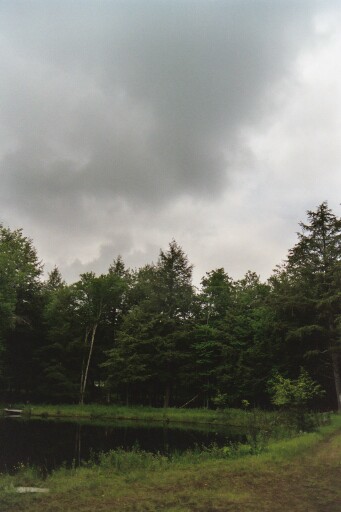
Works Cited
Dowhan, Joseph."Significant Habitats and Habitat Complexes of the New York Bight Watershed". U.S.Fish and Wildlife Service. November 1997. May 23,2003.
http://training.fws.gov/library/pubs5/web_link/text/chp_form.htm
Foster, R.M. "Walking Through Time". Onteora Scout Reservation. 2002. May 23,2003.
http://www.billcotter.com/onteora/walking.htm
Francis, Austin McK.. Land of Little Rivers. The Beaverkill Press. 1999. NY, NY.
Heinberg, Richard. Celebrate the Solstice. Quest Books.1993. Wheaton,IL.
Parrish-Harra, Carol E.. The Book of Rituals. IBS Press,Inc. 1990.Santa Monica, CA.
Powell, Joan. Beaverkill Valley-A Journey Through Time.B and P Publishing. 1999. Lew Beach, NY.
Quinlan, James Eldridge. History of Sullivan County. W.T.Morgans and Co..1873. Liberty,NY.
Willis, Joseph F..The Pioneer: A Commemorative Book. The Livingston Manor Central School Board of Education. 1939. Livingston Manor, NY.